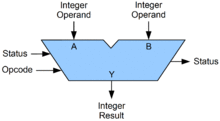
Back وحدة الحساب والمنطق Arabic Аритметично-логическо устройство Bulgarian অ্যারিথমেটিক লজিক ইউনিট Bengali/Bangla Unitat aritmeticològica Catalan Aritmeticko-logická jednotka Czech Arithmetisch-logische Einheit German Αριθμητική και Λογική Μονάδα Greek Aritmetika-logika unuaĵo Esperanto Unidad aritmética lógica Spanish Aritmeetika-loogikaplokk Estonian

| Part of a series on | |||||||
| Arithmetic logic circuits | |||||||
|---|---|---|---|---|---|---|---|
| Quick navigation | |||||||
|
Components
|
|||||||
|
See also |
|||||||
In computing, an arithmetic logic unit (ALU) is a combinational digital circuit that performs arithmetic and bitwise operations on integer binary numbers.[1][2] This is in contrast to a floating-point unit (FPU), which operates on floating point numbers. It is a fundamental building block of many types of computing circuits, including the central processing unit (CPU) of computers, FPUs, and graphics processing units (GPUs).[3]
The inputs to an ALU are the data to be operated on, called operands, and a code indicating the operation to be performed; the ALU's output is the result of the performed operation. In many designs, the ALU also has status inputs or outputs, or both, which convey information about a previous operation or the current operation, respectively, between the ALU and external status registers.
- ^ Atul P. Godse; Deepali A. Godse (2009). "3". Digital Logic Design. Technical Publications. pp. 9–3. ISBN 978-81-8431-738-1.[permanent dead link]
- ^ Atul P. Godse; Deepali A. Godse (2009). "Appendix". Digital Logic Circuits. Technical Publications. pp. C–1. ISBN 978-81-8431-650-6.[permanent dead link]
- ^ "1. An Introduction to Computer Architecture - Designing Embedded Hardware, 2nd Edition [Book]". www.oreilly.com. Retrieved 2020-09-03.